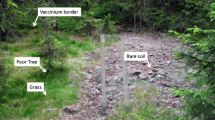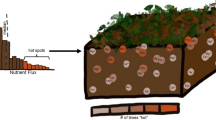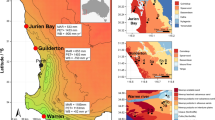Abstract
Few studies of silicate mineral weathering have been conducted in carbonate-bearing temperate forest soils. With climate and vegetation held constant, we compared soil mineralogy and major element chemistry of soil waters from a carbonate-free temperate aspen forest site in the Cheboygan watershed, northern Michigan, with that from carbonate-containing soils from experimental tree-growth chambers (low- vs. high- fertility). All soils were well-drained sands (quartz, Na-rich plagioclase, and K-feldspar) with minor amounts of carbonate present only in the experimentally manipulated soils. The Na+ concentrations in soil waters corrected for atmospheric deposition (Na*) were used to compare relative rates of plagioclase feldspar weathering across sites. In natural soil water profiles, maximum concentrations of Na*, Si, and dissolved organic carbon (DOC) were observed by a depth of 15 cm, a soil zone free of carbonate minerals. Mean Na* and DOC concentrations were different in the three soils, and increased in the order natural soil < low-fertility chambers < high-fertility chambers. While low pH environments are generally viewed as enhancing weathering rates, here higher Na* appears to be related to high DOC, which is consistent with observed increases in active organic functional groups as pH increases. Our results suggest that under a specific vegetative cover, the soil carbon environment affects the weathering flux observed. Our study also suggests that disturbed soils provide an enhanced physical and chemical environment for weathering. Generalized silicate weathering models may benefit from including the enhancing effects of organic anions at moderate pH in addition to precipitation and temperature.






Similar content being viewed by others
References
Andrews JA, Schlesinger WH (2001) Soil CO2 dynamics, acidification, and chemical weathering in a temperate forest with experimental CO2 enrichment. Global Biogeochem Cycles 15:149–162
Blake RE, Walter LM (1996) Effects of organic acids on the dissolution of orthoclase at 80 degrees C and pH 6. Chem Geol 132:91–102
Bluth GJS, Kump LR (1994) Lithologic and climatologic controls of river chemistry. Geochim Cosmochim Acta 58:2341–2359
Bormann FH, Likens GE (1994) Pattern and process of a forested ecosystem. Springer, Berlin Heidelberg, New York
Bormann BT, Wang D, Bormann FH, Benoit G, April R, Snyder MC (1998) Rapid, plant-induced weathering in an aggrading experimental ecosystem. Biogeochemistry 43:129–155
Brady NC (1990) The nature and property of soils. Macmillan Publishing, New York
Brady V, Carroll SA (1994) Direct effect of CO2 and T on silicate weathering: possible implications for climate control. Geochim Cosmochim Acta 58:1853–1856
Chou L, Wollast R (1984) Study of the weathering of albite at room temperature and pressure with a fluidized bed reactor. Geochim Cosmochim Acta 48:2205–2218
Cronan CS, Aiken GR (1985) Chemistry and transport of soluble humic substances in forested watersheds of the Adirondack Park, New York. Geochim Cosmochim Acta 49:1697–1705
Cronan CS, Driscoll CT, Newton RM, Kelly JM, Schofield CL, Bartlett RJ, April R (1990) A comparative analysis of aluminum biogeochemistry in a northeastern and a southeastern forested watershed. Water Resour Res 26:1413–1430
Curtis S, Vogel CS, Wang XZ, Pregitzer KS, Zak DR, Lussenhop J, Kubiske M, Teeri JA (2000) Gas exchange, leaf nitrogen, and growth efficiency of Populus tremuloides in a CO2−enriched atmosphere. Ecol Appl 10:3–17
Department of Geology, Western Michigan University (1981) Glacial drift thickness. Hydrogeologic atlas of Michigan. Department of Geology, Western Michigan University, Kalamazoo
Derry LA, Kurtz AC, Ziegler K, Chadwick OA (2005) Biological control of terrestrial silica cycling and export fluxes to watersheds. Nature 433:728–731
Dorr JA Jr, Eschman DF (1970) Geology of Michigan. University of Michigan Press, Ann Arbor
Drever JI (1994) The effect of land plants on weathering rates of silicate minerals. Geochim Cosmochim Acta 58:2325–2332
Drever JI, Zobrist J (1992) Chemical weathering of silicate rocks as a function of elevation in the southern Swiss Alps. Geochim Cosmochim Acta 56:3209–3216
Farrand WR (1982) Quaternary geology of Southern Michigan. Geological Survey, Department of Natural Resources, State of Michigan, Lansing, MI
Futyma RP (1981) The northern limits of glacial Lake Algonquin in Upper Michigan. Quat Res 15:291–310
Hope D, Billett MF, Milne R, Brown TAW (1997) Exports of organic carbon in British rivers. Hydrol Process 11:325–344
Hughes S, Norris DA, Stevens A, Reynolds B, Williams T, Woods C (1994) Effects of forest age on surface drainage water and soil solution aluminium chemistry in stagnopodzols in Wales. Water Air Soil Poll 77:114–139
Humborg C, Smedberg E, Blomqvist S, Mörth C-M, Brink J, Rahm L, Danielsson Å, Sahlberg J (2004) Nutrient variations in boreal and subarctic Swedish rivers: landscape control of land–sea fluxes. Limnol Oceanogr 49:1871–1883
Jobbágy EG, Jackson RB (2004) The uplift of soil nutrients by plants: biogeochemical consequences across scales. Ecology 85:2380–2389
Johnson DW, Walker RF, Ball JT (1995) Lessons from lysimeters: soil N release from disturbance compromises controlled environment study. Ecol Appl 5:395–400
Ku TCW (2001) Organic carbon–mineral interactions in near surface environments: implications for the global carbon cycle. PhD thesis, University of Michigan, Ann Arbor
Larsen CE (1987) Geological history of glacial Lake Algonquin and the upper Great Lakes. US Geological Survey Bulletin 1801, US Geological Survey
Likens GE, Bormann FH (1995) Biogeochemistry of a forested ecosystem. Springer, Berlin Heidelberg, New York
Lovett GM, Linkens GE, Buso DC, Driscoll CT, Bailey SW (2005) The biogeochemistry of chlorine at Hubbard Brook, New Hampshire, USA. Biogeochemistry 72:191–232. DOI 10.1007/s10533-004-0357-x
Lundström U, Öhman L-O (1990) Dissolution of feldspars in the presence of natural, organic solutes. J Soil Science 41:359–369
Mast MA, Drever JI (1990) Chemical weathering in the Loch Vale Watershed, Rocky Mountain National Park, Colorado. Water Resour Res 26:2971–2978
Millot R, Gaillardet J, Dupré B, Allègre CJ (2003) Northern latitude chemical weathering rates: clues from the Mackenzie River Basin, Canada. Geochim Cosmochim Acta 67:1305–1329
Moulton KL, Berner RA (1998) Quantification of the effect of plants on weathering: studies in Iceland. Geology 26:895–898
Moulton KL, West J, Berner RA (2000) Solute flux and mineral mass balance approaches to the quantification of plant effects on silicate weathering. Am J Sci 300:539–570
National Atmospheric Deposition Program (NRSP-3)/National Trends Network (2003) NADP Program Office, Illinois State Water Survey, Champaign. URL http://nadp.sws.uiuc.edu/sites/ntnmap.asp?
Nezat CA, Blum JD, Klaue A, Johnson CE, Siccama TG (2004) Influence of landscape position and vegetation on long-term weathering rates at the Hubbard Brook Experimental Forest, New Hampshire, USA. Geochim Cosmochim Acta 68:3065–3078
Öberg G, Sandén P (2005) Retention of chloride in soil and cycling of organic matter-bound chlorine. Hydrol Process 19:2123–2136
Öberg G, Nordlund E, Berg B (1996) In situ formation of organically bound halogens during decomposition of Norway spruce litter—effects of fertilization. Can J For Res 26:1040–1048
Ochs M (1996) Influence of humified and non-humified natural organic compounds on mineral dissolution. Chem Geol 132:119–124
Oliver BG, Thurman EM, Malcolm RL (1983) The contribution of humic substances to the acidity of colored natural waters. Geochim Cosmochim Acta 47:2031–2035
Pearsall DR, Barnes BV, Zogg GR, Lapin M, Ring RM (1995) Landscape ecosystems of the University of Michigan Biological Station. School of Natural Resources and Environment, University of Michigan, Ann Arbor
Perdue EM, Reuter JH, Parrish RS (1984) A statistical model of proton binding by humus. Geochim Cosmochim Acta 48:1257–1263
Petrovich R (1981) Kinetics of dissolution of mechanically comminuted rock-forming oxides and silicates. 1. Deformation and dissolution of quartz under laboratory conditions. Geochim Cosmochim Acta 45:1665–1674
Raulund-Rasmussen K, Borggaard OK, Hansen HCB, Olsson M (1998) Effect of natural organic soil solutes on weathering rates of soil minerals. Eur J Soil Sci 49:397–406
Raymond PA, Cole JJ (2003) Increase in the export of alkalinity from North America’s largest river. Science 301:88–91
Reardon EJ, Allison GB, Fritz P (1979) Seasonal chemical and isotopic variations of soil CO2 at Trout Creek, Ontario. J Hydrol 43:355–371
Rustad LE, Fernandez IJ, David MB, Mitchell MJ, Nadelhoffer KJ, Fuller RB (1996) Experimental soil acidification and recovery at the Bear Brook watershed in Maine. Soil Sci Soc Am J 60:1933–1943
Soulsby C, Reynolds B (1992) Modelling hydrological processes and aluminium leaching in an acid soil at Llyn Brianne, Mid-Wales. J Hydrol 138:409–429
Stillings LL, Drever JI, Brantley SL, Sun Y, Oxburgh R (1996) Rates of feldspar dissolution at pH 3–7 with 0–8 mM oxalic acid. Chem Geol 132:79–89
U.S. Department of Agriculture, Soil Conservation Service (1991) Soil Survey of Cheboygan County, Michigan
Vance GF, David MB (1991) Chemical characteristics and acidity of soluble organic substances from a northern hardwood forest floor, central Maine, USA. Geochim Cosmochim Acta 55:3611–3625
Velbel MA (1993) Temperature dependence of silicate weathering in nature: how strong a negative feedback on long term accumulation of atmospheric CO2 and global greenhouse warming. Geology 21:1059–1062
White AF, Blum AE (1995) Effects of climate on chemical weathering in watersheds. Geochim Cosmochim Acta 59:1729–1747
Williams EL, Walter LM, Ku TCW, Kling GW, Zak DR (2003) Effects of CO2 and nutrient availability on organic and inorganic carbon export from the rooting zone in controlled tree growth experiments. Global Biogeochem Cycles 17:article 1041. DOI 10.1029/2002GB001925
Acknowledgments
Support for this project was provided by the U.S. Environmental Protection Agency’s Water and Watersheds Program (EPA R 82979-01-0), the National Science Foundation (EAR 0208182), and the NSF Integrated Graduate Education and Research Training Program’s Biosphere Atmosphere Research Training fellowship. The U.S. Department of Energy (DE-FG02-93ER6166) provided support to construct and maintain the chamber experiments. The authors are grateful to University of Michigan Biological Station personnel for excellent logistical support. Andrea Klaue and Professor Joel D. Blum (Department of Geological Sciences, University of Michigan) are thanked for assistance with LiBO2 digests and a portion of the ICP-OES analyses.
Author information
Authors and Affiliations
Corresponding author
Rights and permissions
About this article
Cite this article
Williams, E.L., Walter, L.M., Ku, T.C.W. et al. Silicate weathering in temperate forest soils: insights from a field experiment. Biogeochemistry 82, 111–126 (2007). https://doi.org/10.1007/s10533-006-9057-z
Received:
Accepted:
Published:
Issue Date:
DOI: https://doi.org/10.1007/s10533-006-9057-z




